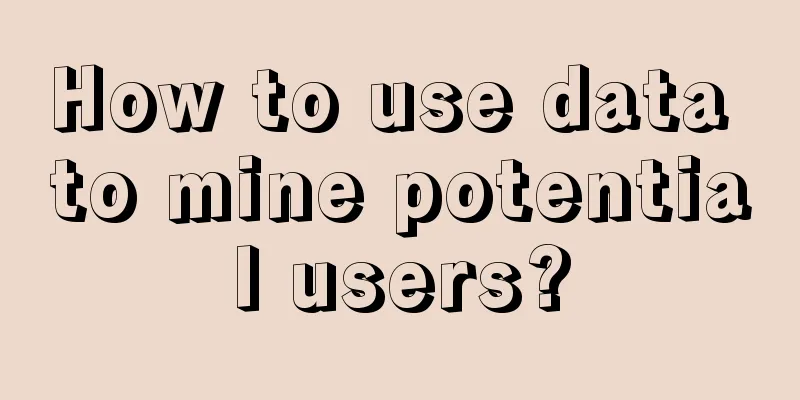How to use data to mine potential users?

"Which customers have potential?" is a difficult problem for many students in their daily work. What is considered potential? How to use data mining? It is not clear. Often, students who work on data work hard, and then the business complains: "I knew it a long time ago, what basis do you have for what you said!" 1. Common PracticesLet’s look at a specific problem scenario: An Internet advertising platform, whose main customers are Class B enterprises, now needs to tap into potential customers. How should it conduct the analysis? Note: The title is about toB business, and the biggest difference from toC business is that B-side customers have fixed industry affiliations (automobiles, beauty, fast-moving consumer goods, games, etc.), and B-side customers also have differences in business scale (which can be obtained from the number of employees in the company, publicly available financial reports, third-party industry reports, etc.). Therefore, if you do your homework in advance, you can label the company and classify the industry and scale. So many students start to do cross analysis as soon as they get the question. They use the industry and enterprise size labels as classification dimensions and cross analyze the amount of user advertising. They get a table like the one below and then start to say: Because enterprises in industry A place more advertisements, enterprises in industry A are all potential customers... (as shown in the following figure) Of course, this result will be criticized by the business:
So, what's the problem? 2. Difficulty of the ProblemEssentially, the difficulty of the problem lies in how to define the word "potential" in business terms. The data can only tell you:
However, these are just descriptions of the current situation and cannot be used as a standard for judging "potential". If we do not talk about the standard and simply describe the current situation, problems and doubts will arise:
There is no solution to the similar chicken and egg problem. Therefore, the solution to this problem is not to crisscross the data here and there, but to get back to the business and see what the so-called "potential" of the business means in different scenarios. 3. Differentiate between scenariosAs an advertising business, there are three key customer attributes that determine whether customers will continue to place ads:
Therefore, when distinguishing scenarios, customers must first be distinguished according to the following dimensions to facilitate subsequent identification work:
Secondly, as a toB business, customer churn may not be entirely a problem of our platform, but may very likely be a problem of the customer’s own industry/enterprise. for example:
If it is case 3, it can still be regarded as potential, after all, there is still an opportunity for educational incubation, but if it is case 1 or 2, it is really hopeless. Therefore, it needs to be treated differently. Note: Data collection here will be very difficult. Because it may involve dozens or hundreds of industries and tens of thousands or even hundreds of thousands of companies, it is too difficult to collect them one by one. Therefore, it is necessary to do a good job of basic classification first, and then focus on them one by one. Thirdly, as a toB business, the business side has more one-on-one customer communication opportunities and the possibility of guiding customers. Therefore, it is necessary to do a good job of benchmark analysis to find out the successful cases/successful benchmarks in the key customer groups. This can help the business side better follow up on potential customers and also answer a very fatal question that the business side often asks: "Why do you say it is potential, but it is not manifested?" The answer is: "Dear, that's because you didn't use the right method..." After completing the above preparations, you will have the basic materials for analyzing potential customers and can officially start work. 4. Defining PotentialConsidering that the amount of data that can be collected is different in different life cycles, it is recommended to use life cycle as the main division dimension and make judgments based on other information. 1. Initial entry periodThe overall idea of the initial analysis is to make one order. Try to activate the newly acquired users to recharge/first launch. Because there is no user launch data in the initial stage, it can only be classified according to basic information such as industry and scale. Here, you can conduct a portrait analysis of existing high-value users, find out the characteristics of industry, scale, etc., and focus on customers with similar characteristics in the initial stage (as shown in the figure below). 2. Trial periodDuring the trial period, some user data is available, and users have begun to differentiate: some users have indeed made money after the campaign, while some users have had a terrible effect and their activity is already very low. At this time, the idea of tapping potential is to keep the seeds. Because it is too difficult to convince users with poor results to continue the campaign, you can focus on keeping those customers who have the potential to become high-value users. 3. Peak periodDuring the peak period, except for users who lost during the trial period, those who can enter the peak period either have sufficient funds for the campaign or have made great gains in previous campaigns, so they all have the opportunity to continue to tap potential. The ideas for tapping potential are also different. If you have made great gains before, you can promote cross-selling and new campaign products. If the effect is average, but there is still a lot of investment, you can promote competitive product cases in the same industry in the form of services, and improve the quality while increasing payment. In short, the two directions of tapping potential are: to increase the average order value. 4. DeclineDuring the decline phase, prioritize identifying the customer’s decline reasons.
Because the above problems all involve data collection, we can stratify the user value and focus on high-value users to solve the problem of large customer decline first. At this time, the goal of tapping potential is to keep the existing investment and save as much as possible. 5. Churn periodThe churn period is similar to the decline idea. First, we need to distinguish the reasons for churn. Eliminate normal deaths and focus on high-value users. Then, when the user industry recovers and new success stories emerge in the user industry, we can explore potential, with the goal of recalling users. 5. The Big PictureAfter the above classification, we have a preliminary definition of "potential users" in each life cycle. However, we do not have to push all "potential users" to the business at once. Because the business focus is different at different stages, so so much information may not be needed. For example, if the current business focus is to attract new users, then focus on solving the potential problems in the initial entry/trial period. If the current focus is to improve productivity, then focus on tapping the peak/decline period users. There is another situation, that is, the business has already had an action plan, and hopes that the data can find users who meet this action plan. At this time, the "potential" is actually very clear: customers who have the potential to participate in XX activities and have the potential to purchase XX products. The approach at this point is completely different from the above, because the meaning of "potential" is already very clear, it's just a matter of matching. I will share this type of approach later. Some students may ask: Can we build an algorithm model here without using business rules to deduce? Answer: Yes. But please note: what we need to build is not an algorithm model, but segmentation scenarios and modeling based on data characteristics. Otherwise, if we do not do everything at once, the model we build will have problems. Author: Down-to-earth Teacher Chen Source: WeChat public account "Down-to-earth Teacher Chen (ID: gh_abf29df6ada8)" |
Recommend
The root causes of brand failure
The author of this article analyzes in detail the ...
Is it easy to run a foreign trade soho? How much can you earn in a year by running a foreign trade soho?
Whether a foreign trade SOHO is easy to do and whe...
Is Lazada profitable? How to run a store?
Nowadays, cross-border e-commerce is developing mo...
Brand Upgrading? The Truth Planners Need to Understand
What does "brand starts high but product ends...
An in-depth review of Pinduoduo’s rise
This article is an in-depth review of Pinduoduo, a...
The internet celebrity became an AI girlfriend, earning 720,000 yuan a month?
This article analyzes the "Ban Zang Forest&qu...
Practical sharing of video account operation
How can a video account be operated to make money?...
What are the types of infringements on Amazon? What are they specifically?
Speaking of Amazon infringement, it is actually di...
How much does Amazon charge for opening multiple sites? How to open a store?
For sellers who want to enter the international ma...
What are the most popular products on Amazon? Introduction to the seven best-selling products
Amazon's platform covers a wide market, but it...
What is the interview process for Shopee Singapore? Will there be a rejection letter during the Shopee interview?
As the headquarters of Shopee, Singapore's int...
To do marketing well in 2025, you need to do four things well:
In 2025, the marketing field faces many challenges...
3.14 million followers in 3 days, overwhelming traffic hits "grassroots internet celebrity" Guo Youcai
Recently, Guo Youcai has become popular in Heze, S...
Help, are copywriters going to lose their jobs to poets?
Nowadays, copywriting is becoming more and more di...
Is “Healthy Milk Tea” a tax on your IQ?
Health preservation for college students, health p...









